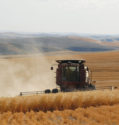Advertise Follow Us
Items Tagged with 'volunteer wheat'
ARTICLES
No-Till Works Under Tough Conditions
No-till offers more options than other tillage systems with John Aeschliman’s steep slopes, limited moisture and extremely hot summer weather.
Read More






